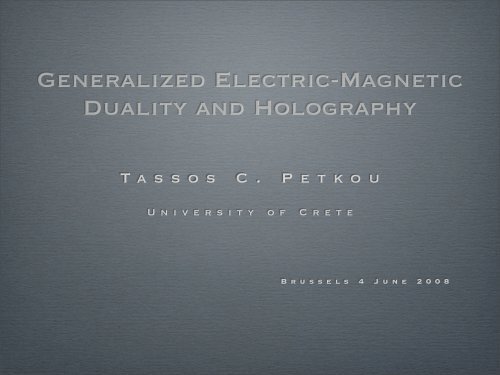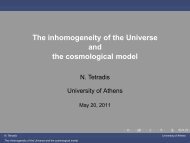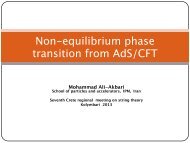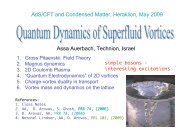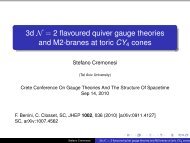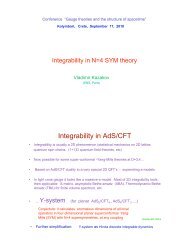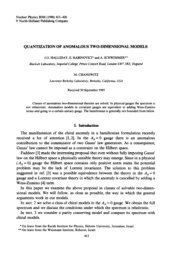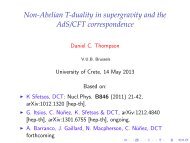Generalized Electric-Magnetic Duality and Holography
Generalized Electric-Magnetic Duality and Holography
Generalized Electric-Magnetic Duality and Holography
Create successful ePaper yourself
Turn your PDF publications into a flip-book with our unique Google optimized e-Paper software.
<strong>Generalized</strong> <strong>Electric</strong>-<strong>Magnetic</strong><br />
<strong>Duality</strong> <strong>and</strong> <strong>Holography</strong><br />
T a s s o s C . P e t k o u<br />
U n i v e r s i t y o f C r e t e<br />
B r u s s e l s 4 J u n e 2 0 0 8
Plan of the talk<br />
<strong>Generalized</strong> electric-magnetic duality <strong>and</strong> M-<br />
theory: General Remarks.<br />
<strong>Electric</strong>-<strong>Magnetic</strong> <strong>Duality</strong> in Linearized<br />
Gravity: The 3+1 split formalism.<br />
<strong>Electric</strong>-<strong>Magnetic</strong> duality <strong>and</strong> <strong>Holography</strong> -<br />
the relevance of Chern-Simons.<br />
Torsion <strong>Holography</strong> - a Janus solution.
<strong>Electric</strong>-<strong>Magnetic</strong> <strong>Generalized</strong> <strong>Electric</strong>-<strong>Magnetic</strong> <strong>Duality</strong> in Linearized <strong>Duality</strong> <strong>and</strong> Gravity: M-theory: The 3+1 General split formalism Remarks<br />
K<br />
Q: What is String Theory<br />
A: It is the Holographic Geometrization of YM Gauge Theories<br />
St<strong>and</strong>ard Model of <strong>Holography</strong><br />
Known<br />
α ′ → 0<br />
SUGRA<br />
Strongly<br />
Coupled<br />
Unknown<br />
λ = g 2 Y MN → ∞<br />
Strings<br />
HOLOGRAPHY<br />
Gauge<br />
Theory<br />
α ′ → ∞<br />
Unknown<br />
HS <br />
Weakly<br />
Coupled<br />
Known<br />
λ = g 2 Y MN → 0
<strong>Electric</strong>-<strong>Magnetic</strong> <strong>Generalized</strong> <strong>Electric</strong>-<strong>Magnetic</strong> <strong>Duality</strong> in Linearized <strong>Duality</strong> <strong>and</strong> Gravity: M-theory: The 3+1 General split formalism Remarks<br />
Q: What is the Holographic Geometrization of non-YM Theories<br />
A: M-Theory ()<br />
Non-St<strong>and</strong>ard Model of <strong>Holography</strong><br />
d = 4 d = 3<br />
Conformal Scalars,<br />
Strongly<br />
Coupled<br />
Known<br />
K<br />
HS <br />
M-Theory <br />
Gauge Fields,<br />
Conformal Gravity<br />
“Double-Trace”<br />
Deformations<br />
3-d CFT Models:<br />
O(N), Gross-Neveu,<br />
Thirring...<br />
Unknown<br />
...<br />
Weakly<br />
Coupled<br />
HOLOGRAPHY<br />
Known<br />
[Klebanov & Polyakov (03)]<br />
[Leigh & T.P. (03)]<br />
Sezgin & Sundell (04)<br />
γ s =→ s→∞ 2γ 1<br />
[<br />
1 − 3 2s + · · · ]
<strong>Electric</strong>-<strong>Magnetic</strong> <strong>Generalized</strong> <strong>Electric</strong>-<strong>Magnetic</strong> <strong>Duality</strong> in Linearized <strong>Duality</strong> <strong>and</strong> Gravity: M-theory: The 3+1 General split formalism Remarks<br />
The <strong>Duality</strong> Conjecture: R.G. Leigh & T.C.P. (hep-th/0309177)<br />
“Linearized higher-spin gauge fields on AdS4 possess a generalization of<br />
electric-magnetic duality that is seen holographically in the boundary.”<br />
Some recent works:<br />
Spin-1 gauge fields: S. deHaro & G. Peng (hep-th/0701144), C. Herzog et. al. (hep-th/<br />
0701036), G. Barnich & A. Gomberoff (arXiv.07082378)<br />
Spin-2 (gravity): M. Henneaux & C. Teitelboim (gr-qc/0408101), R. G. Leigh & T. C. P.<br />
arXiv 0704.0531<br />
DIMENSION<br />
Weyl “shadow” symmetry of O(4, 1)<br />
UNITARITY BOUND<br />
2<br />
“double-trace<br />
deformation<br />
1<br />
0<br />
Dualization & “double-trace” deformations<br />
1<br />
2<br />
SPIN
<strong>Generalized</strong> <strong>Electric</strong>-<strong>Magnetic</strong> <strong>Duality</strong> <strong>and</strong> M-theory: General Remarks<br />
The Gr<strong>and</strong> Picture (Speculative)<br />
Bagger-Lambert<br />
Theory<br />
M2-branes<br />
<strong>Holography</strong> - Boundary Conditions<br />
M-theory<br />
-<br />
11d SUGRA<br />
E11, E10<br />
dualities<br />
M5-branes<br />
Quantum <strong>Duality</strong> of 3-d CFTs<br />
(T.C.P. hep-th/9410093)
<strong>Electric</strong>-<strong>Magnetic</strong> <strong>Duality</strong> in Linearized Gravity: The 3+1 split formalism<br />
<strong>Duality</strong> in the Hamiltonian formalism:<br />
Canonical transformations leaving invariant the form of the Hamiltonian.<br />
p ↦→ q , q ↦→ −p , I =<br />
∫ b<br />
a<br />
[p ˙q − H(p, q)] ↦→ I D =<br />
∫ b<br />
a<br />
Deser & Teitelboim (76)<br />
[−qṗ − H(q, −p)]<br />
H(q, −p) = H(q, p) ⇒ I D = I − pq∣ b δq∣ a⇒ b 0 ↦→ δp∣ a= b 0<br />
a=<br />
Example 1: H(p, q) = 1 2 (p2 + q 2 )<br />
Example 2:<br />
H(p, q; λ) = 1 2 (p2 + q 2 + 2λpq) = H(q, −p; −λ)<br />
In Example 2, the 2nd order e.o.m. remain invariant.<br />
Example 2 allows a modified duality transformation <strong>and</strong> “mixed” B.C..<br />
p ↦→ q , q ↦→ −p − 2λq ⇒ I(λ) ↦→ I(λ) − (pq + λq 2 ∣<br />
) , ⇒ δ(p + 2λq) ∣ b 0<br />
a=<br />
∣ b a
<strong>Electric</strong>-<strong>Magnetic</strong> <strong>Duality</strong> in Linearized Gravity: The 3+1 split formalism<br />
I =<br />
∫<br />
dt ∧<br />
Example 1: Electromagnetism<br />
{<br />
A˙<br />
∧ ∗ 3 E − 1 }<br />
2 (E ∧ ∗ 3E + B ∧ ∗B) − A 0 ˜d ∗3 E<br />
See Glenn’s talk<br />
, B = ∗ 3 ˜dA<br />
E ↦→ −B , B = ∗ 3 ˜dA ↦→ ∗3 E<br />
I ↦→<br />
∫<br />
dt ∧<br />
{<br />
−ȦD ∧ ∗ 3 B − 1 }<br />
2 (E ∧ ∗ 3E + B ∧ ∗B) + A 0 ˜d ∗3 B<br />
, ˜dA D = ∗ 3 E<br />
The Gauss Law maps to the Bianchi identity. Then, we can write:<br />
I ↦→ I D = I −<br />
∫<br />
A D ∧ ˜dA<br />
The boundary modification is a Chern-Simons term.
<strong>Electric</strong>-<strong>Magnetic</strong> <strong>Duality</strong> in Linearized Gravity: The 3+1 split formalism<br />
Example 2: 4d Gravity<br />
Henneaux & Teitelboim (04), Julia et. al. (05) Leigh & T.C.P. (07)<br />
Consider the st<strong>and</strong>ard Hilbert-Palatini action.<br />
∫<br />
I =<br />
(e a ∧ e b ∧ R cd + Λ )<br />
2 ea ∧ e b ∧ e c ∧ e d<br />
ɛ abcd<br />
R a b = dω a b + ω a c ∧ ω c b = 1 2 Ra bcde c ∧ e d<br />
The e.o.m. are:<br />
Λ > 0<br />
corresponds to AdS.<br />
R ab + Λe a ∧ e b = 0 , T a = de a + ω a b ∧ e b = 0<br />
The 3+1 split is the choice:<br />
e 0 = σ ⊥ n = Ndt , e α = ẽ α + N α dt
<strong>Electric</strong>-<strong>Magnetic</strong> <strong>Duality</strong> in Linearized Gravity: The 3+1 split formalism<br />
We split everything:<br />
ω a b = q a bdt + ˜ω a b , R a b = ˜R a b + dt ∧ r a b<br />
We define:<br />
r a b = ˙˜ω a b = ˜dq a b − ˜ω a bq c b + q a c ˜ω c b<br />
The action becomes:<br />
I HP = 2ɛ αβγ<br />
∫<br />
dt ∧<br />
{<br />
N<br />
( ˜Rαβ + Λẽ α ∧ ẽ β) ∧ ẽ γ − 2N α ˜R0β ∧ ẽ γ<br />
+r 0α ∧ ẽ β ∧ ẽ γ}
<strong>Electric</strong>-<strong>Magnetic</strong> <strong>Duality</strong> in Linearized Gravity: The 3+1 split formalism<br />
The dynamics is carried by the terms:<br />
2ɛ αβγ r 0α ∧ ẽ β ∧ ẽ γ = Π α ∧ ˙ẽ α + 4q 0α ɛ αβγ ˜T β ∧ ẽ γ + 2σ ⊥ q αδ ɛ αβγ K δ ∧ ẽ β ∧ ẽ γ<br />
with the definitions:<br />
Π α = −4σ ⊥ ɛ αβγ K β ∧ ẽ γ ,<br />
˜T α = dẽ α ∧ ˜ω α β ∧ ẽ β<br />
The electric field is a vector-valued one-form:<br />
K α = σ ⊥ ˜ω 0 α = K αβ ẽ β ,<br />
˜Rα β = (3) R α β − σ ⊥ K α ∧ K β<br />
˜R 0 α = σ ⊥ ( ˜dK α + K β ∧ ˜ω β α) = σ ⊥ ( ˜DK) α
<strong>Electric</strong>-<strong>Magnetic</strong> <strong>Duality</strong> in Linearized Gravity: The 3+1 split formalism<br />
Define the magnetic field; vector valued one-form too:<br />
B α = 1 2 σ ⊥ɛ αβγ ˜ω βγ ,<br />
˜ω αβ = −ɛ αβγ B γ<br />
The action becomes:<br />
I HP =<br />
∫<br />
dt ∧<br />
{<br />
˙ẽ α ∧ Π α − 4σ ⊥ N α ɛ αβγ ( ˜DK) β ∧ ẽ γ<br />
+2σ ⊥ N<br />
(<br />
2 ˜dB γ + ɛ αβγ B α ∧ B β − ɛ αβγ K α ∧ K β +σ ⊥ Λɛ αβγ ẽ α ∧ ẽ β) ∧ẽ γ<br />
+4q 0α ɛ αβγ ˜T β ∧ ẽ γ + 2q αβ σ ⊥ ɛ ασρ K β ∧ ẽ σ ∧ ẽ ρ}
<strong>Electric</strong>-<strong>Magnetic</strong> <strong>Duality</strong> in Linearized Gravity: The 3+1 split formalism<br />
The q-constraints give:<br />
<strong>and</strong> also:<br />
q αβ ⇒ K [α,β] = 0<br />
ɛ αβγ ˜T β ∧ ẽ γ = ɛ αβγ ˜dẽ β ∧ ẽ γ − σ ⊥ B β ∧ ẽ β ∧ ẽ α = 0<br />
We require that the latter transforms like a vector under SO(3) rotations of<br />
the dreibein. The magnetic field term in an obstruction.<br />
The choice:<br />
B [α,β] = ɛ γ<br />
αβ V γ , V = V α ẽ α , ẽ α ↦→ Λ α βẽ β<br />
(<br />
Λ<br />
−1 ) γ<br />
β ˜dΛ α γ = σ ⊥ V δ α β<br />
⇒ B [α,β] = 0<br />
<strong>and</strong> shows that the antisymmetric part of the magnetic field is a gauge d.o.f.
<strong>Electric</strong>-<strong>Magnetic</strong> <strong>Duality</strong> in Linearized Gravity: The 3+1 split formalism<br />
This is equivalent to choosing the de-Donder gauge:<br />
ɛ αβγ ˜dẽ α ∧ ẽ γ = 0<br />
However, since the magnetic field does not appear in the kinetic term, its<br />
variation gives an algebraic equation; the zero-torsion equation.<br />
˜T α = ˜dẽ α + ɛ αβγ B β ∧ ẽ γ = 0<br />
Only the symmetric part of the magnetic field contributes to that.<br />
Next use the shifted electric field:<br />
ˆK α = K α = ρẽ α<br />
, ρ 2 = σ ⊥ Λ<br />
For, symmetric electric <strong>and</strong> magnetic fields <strong>and</strong> zero torsion we get:<br />
∫ {<br />
I HP = dt ∧ ˙ẽ α ∧ ˆΠ α − 4σ ⊥ N α ɛ αβγ ( ˜D ˆK) β ∧ ẽ γ<br />
(<br />
−2σ ⊥ Nɛ αβγ B α ∧ B β + ˆK α ∧ ˆK β + 2ρ ˆK α ∧ ẽ β) ∧ ẽ γ]}
<strong>Electric</strong>-<strong>Magnetic</strong> <strong>Duality</strong> in Linearized Gravity: The 3+1 split formalism<br />
Linearize as:<br />
ẽ α = ẽ α + E α , N = 1 + n , N α = n α<br />
B α = B α + b α ,<br />
ˆKα = ˆK α + k α<br />
Make an educated guess for a nice background i.e. the vacuum:<br />
B α = 0 = ˆK α<br />
The action becomes:<br />
∫ {<br />
I HP = dt ∧ (Ėα + ρE α ∧ p α − 2σ ⊥ ɛ αβγ (b α ∧ b β + k α ∧ k β ) ∧ ẽ γ<br />
−4σ ⊥ η α ɛ αβγ ˜dk β ∧ ẽ γ + n(4σ ⊥ ˜dbγ + ρp γ ) ∧ ẽ γ}<br />
p α = −4σ ⊥ ɛ αβγ k β ∧ ẽ γ
<strong>Electric</strong>-<strong>Magnetic</strong> <strong>Duality</strong> in Linearized Gravity: The 3+1 split formalism<br />
The vanishing of the linear terms gives:<br />
˙ẽ α + ρẽ α = 0<br />
This is solved by (A)dS4:<br />
ẽ 0 = dt , ẽ α = e −ρt dx α , K α = ρẽ α<br />
Ric ab = − 3σ ⊥<br />
L 2 η ab<br />
, R = − 12σ ⊥<br />
L 2<br />
Finally - the duality map:<br />
k α ↦→ −b α , b α ↦→ k α E ↦→ E , p ↦→ −p D<br />
ɛ αβγ b β ∧ ẽ γ + ˜dE α ↦→ ɛ αβγ k β ∧ ẽ γ + ˜dE α = 0
<strong>Electric</strong>-<strong>Magnetic</strong> <strong>Duality</strong> in Linearized Gravity: The 3+1 split formalism<br />
The action dualizes to:<br />
∫ {<br />
I ↦→ I D = dt ∧ −E ˙α<br />
∧ p D,α − ρẼα ∧ p D,α<br />
−2σ ⊥ ɛ αβγ (b α ∧ b β + k α ∧ k β ) ∧ ẽ γ<br />
+4σ ⊥ n α ɛ αβγ ˜db β ∧ ẽ γ + n(4σ ⊥ ˜dkγ + ρp D,α ) ∧ ẽ γ}<br />
This differs from the initial action by<br />
ρ ↦→ −ρ<br />
Nevertheless, this does not affect the second order e.o.m.<br />
The constraints also dualize to:<br />
C α ≡ ɛ αβγ ˜dk β ∧ e γ ↦→ −ɛ αβγ ˜db β ∧ ẽ γ<br />
C 0 ≡ −σ ⊥ ( ˜db γ − ρɛ αβγ k α ∧ ẽ β ) ∧ ẽ γ ↦→ −σ ⊥ ( ˜dk γ + ρɛ αβγ b α ∧ ẽ β ) ∧ ẽ γ
<strong>Electric</strong>-<strong>Magnetic</strong> <strong>Duality</strong> in Linearized Gravity: The 3+1 split formalism<br />
Recall the linearized Bianchi identities:<br />
B α T = −ɛ αβγ ˜db β ∧ ẽ γ + · · ·<br />
B 0 T = −σ ⊥ ( ˜dk α + ρɛ αβγ b β ∧ ẽ γ ) ∧ ẽ α + · · · = 0<br />
The duality maps the constraints into the Bianchi identities.<br />
C α ↦→ B T,α , C 0 ↦→ B 0 T B T,α ↦→ −C α , B 0 T ↦→ −C 0
<strong>Electric</strong>-<strong>Magnetic</strong> <strong>Duality</strong> in Linearized Gravity: The 3+1 split formalism<br />
Lastly, we notice that the modified duality transformations;<br />
k α ↦→ −b α − 2ρE α , b α ↦→ k α<br />
Leave the action invariant, up to additional terms in the constraints.<br />
−8ρn α k β ∧ ẽ α ∧ ẽ β<br />
8nΛɛ αβγ E β ∧ ẽ γ ∧ ẽ α<br />
Using the relationship between the dual dreibein <strong>and</strong> the electric field;<br />
E α β = 1<br />
∂ 2 ɛα δγ∂ γ k δ β<br />
we can show that the additional terms vanish. Hence, gravity<br />
with a c.c. requires a modified duality transformation.
<strong>Electric</strong>-<strong>Magnetic</strong> <strong>Duality</strong> <strong>and</strong> <strong>Holography</strong>: the relevance of Chern-Simons<br />
with S. de Haro; to appear<br />
<strong>Holography</strong><br />
∫<br />
is equivalent to Hamiltonian dynamics.<br />
δW [q]<br />
δI = pδq + {e.o.m.} , p ≡ = 〈O〉 q<br />
δq<br />
∂M<br />
Removal of divergences --> addition of “boundary” ∫ terms.<br />
I ↦→ I Ren = I + f ct (q)<br />
Addition of other “boundary” terms --> deformation of the “boundary” action.<br />
∫<br />
I Ren ↦→ I def = I Ren + f def (p) , q + f def ′ (p) ∣ = 0<br />
∂M<br />
∂M<br />
<strong>Duality</strong> implies that the switch from Dirichlet to Neumann B.C.s is a C.T.<br />
In Example 2, the switch is from Dirichlet to mixed B.C.s<br />
The “bulk” e.o.m. remain the same:<br />
<strong>Duality</strong> implies that different “boundary” theories (i.e. corresponding to different<br />
B.C.) are equivalent since they correspond to canonically equivalent “bulk” data.<br />
∂M
<strong>Electric</strong>-<strong>Magnetic</strong> <strong>Duality</strong> <strong>and</strong> <strong>Holography</strong>: the relevance of Chern-Simons<br />
The importance of self-dual configurations - Euclidean spaces<br />
Fefferman-Graham holography:<br />
ds 2 = l (<br />
dr 2<br />
r 2 + g ij (r, ¯x)dx i dx j) , g ij (r¯x) = g (0)<br />
ij (¯x) + ... + r3 g (3)<br />
ij (¯x) + ...<br />
δ(I EH + I GH + I ct ) = 1 2<br />
∫<br />
d 3 x √ g (0) g (3)<br />
ij δg(0),ij , 〈T ij (¯x)〉 = 3l2<br />
16πG N<br />
g (3)<br />
ij (¯x)<br />
We need to go on-shell <strong>and</strong> impose B.C. to find g (3)<br />
ij (¯x)<br />
in terms of<br />
g(0) ij (¯x)<br />
We can functionally integrate over g (0)<br />
ij (¯x) to the boundary generating functional<br />
This is a non-local functional, hence it cannot be an effective action for g (0)<br />
ij (¯x)<br />
Gravity is non-dynamical in the boundary.
<strong>Electric</strong>-<strong>Magnetic</strong> <strong>Duality</strong> <strong>and</strong> <strong>Holography</strong>: the relevance of Chern-Simons<br />
In the presence of a c.c. the e.o.m. <strong>and</strong> the Bianchi identities can be written as:<br />
˜W ab ∧ e c = 0 , W a b ∧ e b = 0<br />
W ab = R ab + e a ∧ e b ,<br />
˜W ab = 1 2 ɛab bcW bc<br />
Hence, one can replace the e.o.m. by the self-duality condition:<br />
W ab = ± ˜W ab ⇒ C µνρσ = ± 1 2 ɛ kl<br />
µν C klρσ<br />
We the find that the boundary e.m. tensor is the Cotton tensor:<br />
= C ij = ɛi kl ∇ l<br />
(R jk − 1 )<br />
4 g jkR<br />
g (3)<br />
ij<br />
Similar to Lambda-Instantons: Julia et. al. (05)<br />
This is produced by the variation of the gravitational Chern-Simons action.<br />
The latter can be interpreted as an effective action for g (0)<br />
ij (¯x)<br />
See also: Compere & Marolf (08)
<strong>Electric</strong>-<strong>Magnetic</strong> <strong>Duality</strong> <strong>and</strong> <strong>Holography</strong>: the relevance of Chern-Simons<br />
The physical meaning of the self-dual configurations - consider Example 1:<br />
p ↦→ q , q ↦→ −p : ⇒ H(p, q) = 1 2 (p2 − q 2 ) ↦→ −H(p, q)<br />
The self-dual configurations yield a total derivative action:<br />
p = ±q<br />
⇒ H(p, q) = 0 , ⇒ I = ± 1 2 q2 ∣<br />
∣∣∂M<br />
The boundary “Chern-Simons” action describes all “bulk” states with zero energy.<br />
The Gravitational Chern-Simons describes all zero energy states of 4d gravity.<br />
<strong>Duality</strong> in a trivial automorphism of the Euclidean gravity Hilbert space.
Torsion <strong>Holography</strong> - a Janus solution<br />
with R. G. Leigh <strong>and</strong> N. NNguen; to appear<br />
The Nieh-Yan model<br />
NY = 2R a b ∧ e a ∧ e b − T a ∧ T a = −d(T a ∧ e a )<br />
Consider a modified version of the D’Auria-Regge model.<br />
Equivalent to gravity coupled to a pseudoscalar field.<br />
∫<br />
I NY = I HP − 2 F d(T a ∧ e a ) , F = F (t)<br />
Use the previous gauge fixing.<br />
K α ∧ ẽ α = 0 , B α ∧ ẽ α = 0 , ɛ αβγ ˜dẽ β ∧ ẽ γ = 0<br />
Look for domain-wall solutions.<br />
N = 1 , N α = 0 , ˜dẽ α = 0<br />
The motivation is to give dynamics to the magnetic field.<br />
D’Auria & Regge (82)
Torsion <strong>Holography</strong>: - An a Janus exact solution<br />
I NY =<br />
∫<br />
dt ∧<br />
{<br />
˙ẽ α ∧ (−4σ ⊥ ɛ αβγ K β ∧ ẽ γ ) − 2σ ˙ F ɛ αβγ B α ∧ ẽ β ∧ ẽ γ<br />
+2σ ⊥<br />
(<br />
ɛαβγ<br />
[<br />
σB α ∧ B β − K α ∧ K β] ∧ ẽ γ + σ ⊥ Λɛ αβγ ẽ α ∧ ẽ β ∧ ẽ γ) }<br />
The magnetic field becomes a proper dynamical variable.<br />
Torsion is generally non-zero.<br />
˜T α = −σɛ αβγ B β ∧ ẽ γ = − 1 2 σ 3 ˙ F ɛ αβγ ẽ β ∧ ẽ γ<br />
Using:<br />
The e.o.m. are:<br />
σ ⊥ = σ = 1<br />
Ä(t) + 3 ˙ A(t) 2 − 3σ ⊥ Λ = 0<br />
ẽ α = e A(t) dx α<br />
¨F (t) + 3 ˙ F (t) ˙ A(t) = 0<br />
Ȧ(t) 2 − σ ⊥ Λ = 1 4 σ ˙ F (t) 2
Torsion <strong>Holography</strong>: - An a Janus exact solution<br />
The solution is:<br />
ds 2 = dt 2 + e −2Λt (1 + e 6Λt ) 2 3 dx α dx α , F (t) = ± 4 3 arctan(e3Λt )<br />
It is of the “Janus” type, since:<br />
F or t → ±∞ ⇒ ds 2 → AdS , F (t) → ( 2π 3 , 0)<br />
Quite possibly, there is only one boundary <strong>and</strong> the two limits take us to<br />
different boundary patches.<br />
The electric <strong>and</strong> magnetic fields are:<br />
K α = Λe −Λt<br />
B α = √ 6Λ<br />
1 − e 6Λt<br />
(<br />
(1 + e 6Λt ) 2/3 dxα = Λe −Λt 1 − 5 )<br />
3 e6Λt + ...<br />
e 2Λt<br />
(1 + e 6Λt ) 2/3 dxα = √ 6Λe 2Λt (1 + ..)dx α<br />
dx α
Torsion <strong>Holography</strong> - a Janus solution<br />
The boundary e.m. tensor vanishes.<br />
Notice that the electric field diverges in both boundaries. In the one case, it<br />
has a finite number of divergent terms; can be dealt with Holographic<br />
Renormalization.<br />
In the other case, it has an infinite number of divergent terms; the resulting<br />
boundary theory would seem non-renormalizable.<br />
However, the two theories are very similar; they only differ in the exp.<br />
value of a pseudoscalar dim=3 operator.<br />
δI NY = −2<br />
∫<br />
F (t) ∼ e 3Λt + ... , as t → −∞<br />
∣ ∣∣∣∣<br />
∞ ∫<br />
δF (t)ɛ αβγ B α ∧ ẽ β ∧ ẽ γ = d 3 xδF (t)〈[O + (x)〉 − 〈O − (x)〉]<br />
−∞<br />
〈[O + (x)〉 − 〈O − (x)〉] = 2 √ 6Λ
with D. Mansi & G. Tagliabue: to appear<br />
The complete Holographic analysis of AdS4 gravity in the 3+1 split formalism.<br />
Study of Black Holes, self-dual backgrounds <strong>and</strong> their <strong>Holography</strong>.<br />
Bulk <strong>Electric</strong>-magnetic duality interchanges boundary energy-momentum density<br />
with external geometry.<br />
(In the same way that bulk electric-magnetic duality interchanges boundary<br />
charge-density with external fields: interesting Quantum-Hall, superconductivity<br />
applications.<br />
Herzog, Horowitz, Hartnol, Sachdev et. al. (07-08)
Conclusions<br />
Linearized gravity (<strong>and</strong> Higher-Spins)<br />
possess a generalized electric-magnetic<br />
duality.<br />
The duality has important Holographic<br />
consequences.<br />
The M-theory dualities can be studied<br />
Holographically.


